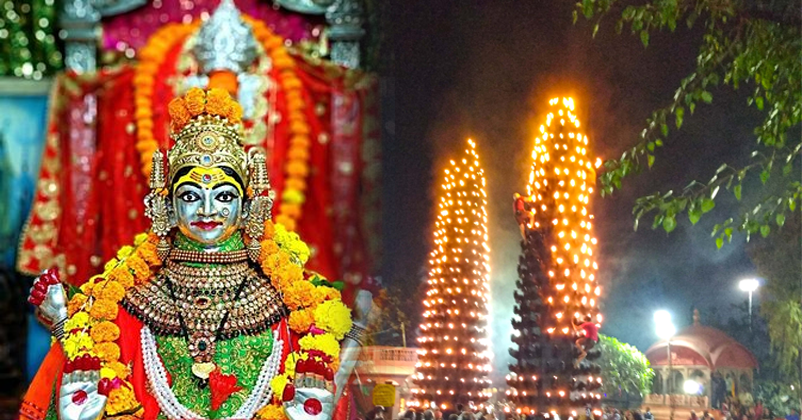Historical Significance of Harshidhi Temple
The origins of Harshidhi Temple are steeped in mythological and historical legends. The temple is believed to have been built around the 11th century, during the time of the Solanki dynasty. However, the story of Harshidhi Mata dates back to the ancient Hindu scriptures. The goddess is considered a manifestation of Shakti, the divine feminine energy, and is revered for her ability to provide strength and protect her devotees from harm. According to local folklore, the temple was constructed by King Bhimdev, who was guided by the goddess's divine intervention. The temple's location is significant too. It sits atop a hill, offering panoramic views of the surrounding landscape, including the lush forests and tranquil surroundings, providing a serene and meditative environment for worshippers. The natural beauty combined with the temple's spiritual significance makes it an ideal destination for those seeking peace and a deeper connection to the divine.
Architectural Beauty of Harshidhi Temple
Harshidhi Temple’s architectural design is a testament to the grandeur and craftsmanship of ancient Indian builders. The temple showcases intricate carvings, sculptures, and ornate decorations that reflect the rich cultural heritage of the region. The main sanctum of the temple is a beautifully designed structure, with the idol of Harshidhi Mata placed at the center. The deity is often depicted as a fierce and compassionate figure, symbolizing both strength and mercy. The temple is built in the classical style of Indian temple architecture, with a blend of Solanki and Chalukya styles. The pillars, walls, and ceilings are adorned with elaborate carvings that depict various gods, goddesses, and scenes from Hindu mythology. These artistic representations offer a glimpse into the spiritual and cultural narratives that have shaped the temple's history.
Religious and Spiritual Importance
For devotees, Harshidhi Temple holds immense spiritual value. The goddess is believed to be the protector of the people, granting them safety, prosperity, and victory over adversities. Pilgrims visit the temple to seek the goddess's blessings, especially for the removal of obstacles, fulfillment of desires, and the acquisition of spiritual strength. In addition to the general prayers for well-being, many people visit the temple during specific festivals like Navratri, Diwali, and other auspicious occasions, when special rituals and prayers are performed. These festivals amplify the spiritual energy of the place, drawing in devotees from far and wide to partake in communal prayers and celebrations. The temple also plays a role in nurturing a sense of community. Visitors not only come to pray but also to find solace in the quiet serenity of the temple complex. The temple acts as a sanctuary for introspection and spiritual rejuvenation, providing people with the opportunity to connect with their inner selves and gain clarity.⭐
Cultural Significance
Beyond its religious importance, Harshidhi Temple is a beacon of cultural heritage. The temple hosts a variety of cultural programs and events throughout the year, such as classical music performances, dance recitals, and exhibitions that showcase regional arts and crafts. This cultural exchange enriches the spiritual experience, offering visitors a more holistic view of the area’s history and traditions. Moreover, Harshidhi Temple is part of a larger pilgrimage circuit in Gujarat, linking it to other important temples in the region. It stands as a vital cultural landmark, contributing to the tourism and economic development of the surrounding area while preserving the traditions and rituals that have existed for centuries. 🙏
A Must-Visit for Pilgrims and Travelers
Visiting Harshidhi Temple is a journey not only of spiritual significance but also of personal growth and exploration. Its tranquil ambiance, combined with the divine blessings of Harshidhi Mata, provides an ideal setting for both religious observance and quiet reflection. Whether you’re a pilgrim seeking divine guidance, a history enthusiast fascinated by the temple's ancient roots, or a traveler appreciating architectural beauty, Harshidhi Temple is a destination that leaves a lasting impression. In conclusion, the significance of Harshidhi Temple extends far beyond its physical structure. It is a symbol of faith, a guardian of cultural heritage, and a spiritual hub where people from all walks of life converge to seek blessings and peace. Its historical, architectural, and cultural importance continues to inspire countless individuals, making it a revered destination for generations to come.
Conclusion
In conclusion, the Harshidhi Temple stands as a timeless symbol of devotion, culture, and heritage. It holds profound spiritual significance for devotees, offering a sanctuary for prayer, reflection, and solace. Its architectural grandeur and historical depth further elevate its importance, making it not only a place of worship but also a cultural landmark that bridges the past and present. Whether one visits to seek divine blessings, explore its rich history, or appreciate the beauty of its surroundings, Harshidhi Temple continues to be a beacon of faith and a testament to the enduring power of spirituality. For generations to come, it will remain a cherished destination that nurtures both the soul and the spirit.

